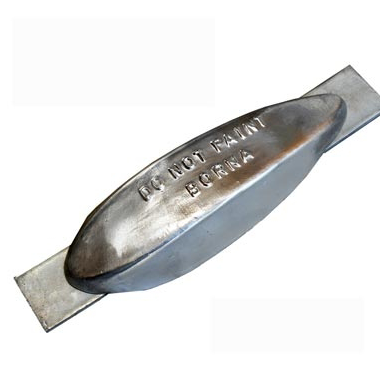zinc anode
Category: sacrificial anode
zinc anode
Zinc anodes are used to protect structures submerged in fresh or salt water.

sacrificial anode
zinc anode

Zinc anodes are used to protect structures submerged in fresh or salt water
Zinc anode:
Zinc anodes are used to protect structures submerged in fresh or salt water. Of course, these anodes are also used to protect structures buried in the soil. Common zinc anode standards include ASTM-B 418, BS 7361, DNV-RP-B401, IPS-M-TP-750, NORSOK M-503, and MIL-A-18001K.
Zinc anodes are divided into the following two categories in terms of chemical composition and type of application:
1) Marine zinc alloy (Type I) designed for use in seawater.
2) Standard zinc alloy (Type II) formulated for use in fresh water and soil.
| Element | Alloy Type I | Alloy Type II |
| Aluminum (%) | 0.1 – 0.5 | 0.005 max |
| Cadmium (%) | 0.025 – 0.07 | 0.003 max |
| Iron (%) | 0.005 max | 0.0014 max |
| Lead (%) | 0.006 max | 0.003 max |
| Copper (%) | 0.005 max | 0.002 max |
| All others (%) | 0.1 max | — |
| Zinc (%) | Remainder | Remainder |
According to the NACE-RP0387 standard, the insert used in zinc anodes must be made of galvanized steel.
According to the BS 7361 standard, the open circuit potential of the zinc anode is about -1.05 V compared to the silver/silver chloride reference electrode, its electrochemical capacity is at least 780 A.h/kg and its consumption rate is at most 11.25 kg/A.year. The efficiency of zinc anodes is also about 90% (the recipe for zinc anode electrochemical test and related calculations is mentioned in the DNV-RP-B401 standard.)
| Electrochemical Properties | Sea Water Environment |
| Electrochemical Capacity .A.h/kg | 780 |
| Open Circuit Potential .V | 1.05- |
| (Respect to Ag/AgCl Reference Electrode) | |
| Efficiency (%) | 90 |
Technical documents of sacrificial zinc anode BornaGodaz:
Anode data sheet sample on a disc shape (Weight=1.4Kg)
Sample data sheet of rectangular zinc anode with welded connection (Gross Weight = 10Kg)
A sample of zinc anode chemical analysis report
Example of zinc anode electrochemical test report
Zinc sacrificial anode technical catalog – English version
Technical catalog of sacrificial zinc anode – Persian version
Obtaining approval from the Asian Classification Institute
Obtaining approval from the Iranian Classification Institute
